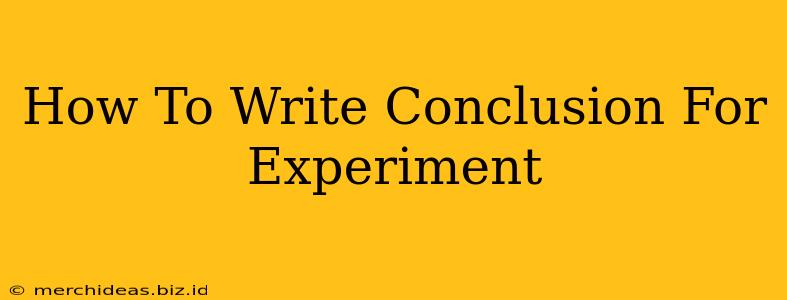Writing a compelling conclusion for your experiment is crucial. It's your final chance to leave a lasting impression and demonstrate a clear understanding of your findings. A well-written conclusion doesn't just summarize; it interprets, analyzes, and connects your results to the broader context of your research. This guide will walk you through crafting a conclusion that will impress your readers and solidify your experiment's impact.
Understanding the Purpose of Your Conclusion
Before diving into the writing process, it's essential to understand what your conclusion should achieve:
- Summarize Key Findings: Briefly restate the main results of your experiment, focusing on the most significant observations. Avoid overwhelming the reader with excessive detail; instead, highlight the core takeaways.
- Interpret the Results: This is where you go beyond simply stating what happened. Analyze the significance of your findings. Do they support your hypothesis? If not, why? What are the possible explanations for any unexpected results?
- Discuss Limitations: No experiment is perfect. Acknowledge any limitations of your methodology, potential sources of error, or factors that may have influenced your results. This demonstrates critical thinking and strengthens your credibility.
- Suggest Future Research: Based on your findings and limitations, suggest avenues for future research that could build upon your work or address unanswered questions. This indicates a forward-thinking approach and contributes to the ongoing scientific process.
- Connect to Broader Context: Place your findings within a larger context. How do your results relate to existing theories or previous research in your field? What are the broader implications of your work?
Structuring Your Conclusion for Maximum Impact
A well-structured conclusion follows a logical flow, guiding the reader to a clear and concise understanding of your experiment's significance. Consider this structure:
1. Restate the Purpose:
Begin by briefly reminding the reader of the experiment's objective. This provides a smooth transition from the results section and sets the stage for your interpretation. For example: "This experiment aimed to investigate the effect of X on Y..."
2. Summarize the Major Findings:
Clearly and concisely summarize your key results. Use quantifiable data where appropriate, but avoid overwhelming the reader with numbers. Focus on the most significant observations that directly relate to your hypothesis.
3. Analyze and Interpret the Results:
This is the most crucial part of your conclusion. Discuss the meaning of your findings. Did your results support your hypothesis? If so, explain why. If not, offer plausible explanations for the discrepancies. Consider factors that may have influenced your results, such as experimental error or confounding variables. Use strong verbs to express your analysis (e.g., "demonstrated," "indicated," "suggested").
4. Address Limitations:
Be upfront about any limitations of your study. This shows that you're aware of the potential weaknesses and that you've critically evaluated your methodology. Examples of limitations include small sample size, uncontrolled variables, or limitations in the techniques used.
5. Suggest Future Research:
Based on your findings and the limitations of your study, propose avenues for future research. This could involve expanding the sample size, refining the experimental design, or exploring related research questions.
6. Broaden the Context:
Connect your findings to the broader context of your field. How do your results contribute to the existing body of knowledge? What are the potential implications of your findings for future research or practical applications?
Example:
Let's say your experiment tested the effect of fertilizer on plant growth. Your conclusion might look something like this:
"This experiment investigated the effect of a nitrogen-based fertilizer on the growth of tomato plants. The results demonstrated a significant increase in plant height and fruit yield in plants treated with the fertilizer compared to the control group (p<0.05). This supports our hypothesis that nitrogen fertilization enhances tomato plant growth. However, the relatively small sample size (n=10) may limit the generalizability of these findings. Future research could explore the optimal concentration of this fertilizer or investigate its effects on other plant species. Overall, these results highlight the potential of nitrogen-based fertilizers as a valuable tool for improving tomato production, contributing to ongoing efforts to enhance agricultural yields."
By following these steps, you can write a conclusion that not only summarizes your experiment's results but also provides insightful analysis, acknowledges limitations, and suggests future research directions, ultimately strengthening the impact and value of your work. Remember to be clear, concise, and confident in your writing.
